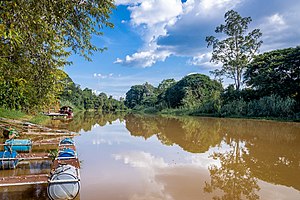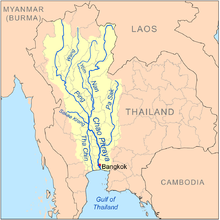Ping River
| Ping River | |
|---|---|
 Ping River at Chiang Mai in October 2020. | |
 Map of the Chao Phraya River drainage basin showing the Ping River | |
| Location | |
| Country | Thailand |
| District | Chiang Mai, Lamphun, Tak, Kamphaeng Phet, Nakhon Sawan |
| Cities | Chiang Mai, Saraphi, San Sai, Kamphaeng Phet, Banphot Phisai |
| Physical characteristics | |
| Source | Khun Ping[1] |
| • location | Doi Thuai, Chiang Mai |
| • coordinates | 19°48′45″N 98°50′20″E / 19.81250°N 98.83889°E |
| • elevation | 1,700 m (5,600 ft) |
Nakhon Sawan | |
• coordinates | 15°42′04″N 100°08′31″E / 15.701°N 100.142°E |
• elevation | 25 m (82 ft) |
| Length | 658 km (409 mi) |
| Basin size | 44,688 km2 (17,254 sq mi) |
| Discharge | |
| • location | Nakhon Sawan |
| • average | 265 m3/s (9,400 cu ft/s) |
| • maximum | 2,302 m3/s (81,300 cu ft/s) |
| Basin features | |
| Progression | Chao Phraya → Gulf of Thailand |
| Tributaries | |
| • left | Ngad River, Kwuang River, Li River, Wang River |
| • right | Taeng River, Chaem River |
The Ping River (Thai: แม่น้ำปิง, RTGS: Maenam Ping, pronounced [mɛ̂ː.náːm pīŋ]), along with the Nan River, is one of the two main tributaries of the Chao Phraya River.[2] It originates at Doi Thuai in the Daen Lao Range, in Chiang Dao district, Chiang Mai province. After passing Chiang Mai, it flows through the provinces of Lamphun, Tak and Kamphaeng Phet. At the confluence with the Nan at Nakhon Sawan (also named Paknam Pho in Thai), it forms the Chao Phraya River.
History
Evidence shows that habitation along the Ping River dates back to 1500 BCE. At that time it controlled trading routes between Yunnan and the Chao Phraya basin.
In the 20th century, the Ping River became a part of
Tributaries
- Khlung River (2)
- Suan Mak River (Joins the Ping at 16°29′42″N 99°29′56″E / 16.49500°N 99.49889°E)
- Wang Chao River (Joins the Ping at 16°41′02″N 99°16′16″E / 16.68389°N 99.27111°E)
- Pra Dang River (Joins the Ping at 16°44′46″N 99°13′05″E / 16.74611°N 99.21806°E)
- Raka River (Placement in tributary tree is approximate, geographical coordinates unavailable due to poor satellite resolution)
- Tak)
- Tak River (Joins the Ping at 17°02′18″N 99°04′00″E / 17.03833°N 99.06667°E)
- Ko River (Joins the Ping at 17°41′17″N 98°45′01″E / 17.68806°N 98.75028°E)
- Tun River (Placement in tributary tree is approximate, geographical coordinates unavailable due to poor satellite resolution)
- Pa River
- Chaem River (Joins the Ping at 18°11′19″N 98°38′02″E / 18.18861°N 98.63389°E)
- Klang River (Joins the Ping at 18°22′12″N 98°40′55″E / 18.37000°N 98.68194°E)
- Li River (Joins the Ping at 18°25′43″N 98°42′08″E / 18.42861°N 98.70222°E)
- Tun River (2) (Placement in tributary tree is approximate, geographical coordinates unavailable due to poor satellite resolution)
- Khan River (2) (Joins the Ping at 18°30′05″N 98°51′04″E / 18.50139°N 98.85111°E)
- Wang River (2) (Joins the Khan at 18°32′58″N 98°51′37″E / 18.54944°N 98.86028°E)
- Kuang River (Joins the Ping at 18°32′33″N 98°56′07″E / 18.54250°N 98.93528°E)
- Tha River (Joins Kuang at 18°32′23″N 98°56′29″E / 18.53972°N 98.94139°E)
- Sapuat River (Placement in tributary tree is approximate, geographical coordinates unavailable due to inaccurate station data from Royal Irrigation Department)
- Tha River (Joins Kuang at 18°32′23″N 98°56′29″E / 18.53972°N 98.94139°E)
- Khanat River (Placement in tributary tree is approximate, geographical coordinates unavailable due to poor satellite resolution)
- San River (Placement in tributary tree is approximate, geographical coordinates presently undeterminable due to recently built dam)
- Tip River (Placement in tributary tree is approximate, geographical coordinates presently undeterminable due to recently built dam)
- Phaem River (Placement in tributary tree is approximate, geographical coordinates unavailable due to poor satellite resolution)
- Mempin River (Placement in tributary tree is approximate, geographical coordinates unavailable due to poor satellite resolution)
- Lai River (2) (Placement in tributary tree is approximate, geographical coordinates unavailable due to poor satellite resolution)
- Sa River (Joins the Ping at 18°53′28″N 98°58′22″E / 18.89111°N 98.97278°E)
- Rim River (Joins the Ping at 18°55′13″N 98°58′02″E / 18.92028°N 98.96722°E)
- Nai River (Placement in tributary tree is approximate, geographical coordinates unavailable due to poor satellite resolution)
- Taeng River (Joins the Ping at 19°06′08″N 98°56′49″E / 19.10222°N 98.94694°E)
- Ngat River (Joins the Ping at 19°09′11″N 99°00′44″E / 19.15306°N 99.01222°E)
Ping Basin
The Ping Basin is one of the largest drainage basins of the Chao Phraya Watershed, draining 33,896 square kilometres (13,087 sq mi) of land.
The greater Ping Basin, i.e. the basin of the entire Ping river system including its tributary the Wang River, drains a total of 44,688 square kilometres (17,254 sq mi).
The main dams in the basin are the Bhumibol Dam and the Doi Tao Dam.
National Parks
The Ping itself originates in Huai Nam Dang National Park and flows through Mae Ping National Park.
Gallery
-
Bathing elephants in the Taeng River, a Ping tributary
-
Ping River north of Chiang Mai
-
Ping River, northern outskirts of Chiang Mai
-
A Ping tributary, the Chaem River flows through the town ofMae Chaem
-
Ping River, upstream from the Bhumibol Dam
-
Bhumibol Dam, 154 metres (505 ft) long, creating a reservoir with a surface area of 300 square kilometres (120 sq mi).
-
Wang River, the main tributary of the Ping, flowing through Lampang
-
Confluence of the Ping with the Nan River at Nakhon Sawan
References
- ^ "Chiang Dao National Park". Thai Forest Booking. Retrieved 2009-05-20.
- ^ "Mae Ping River: Lifeline of Chiangmai Province". Chiangmai and Chiangrai Magazine. 2008. Archived from the original on 2009-11-29. Retrieved 2009-04-02.







